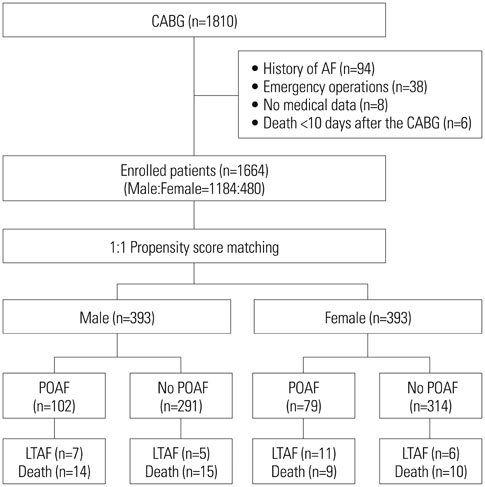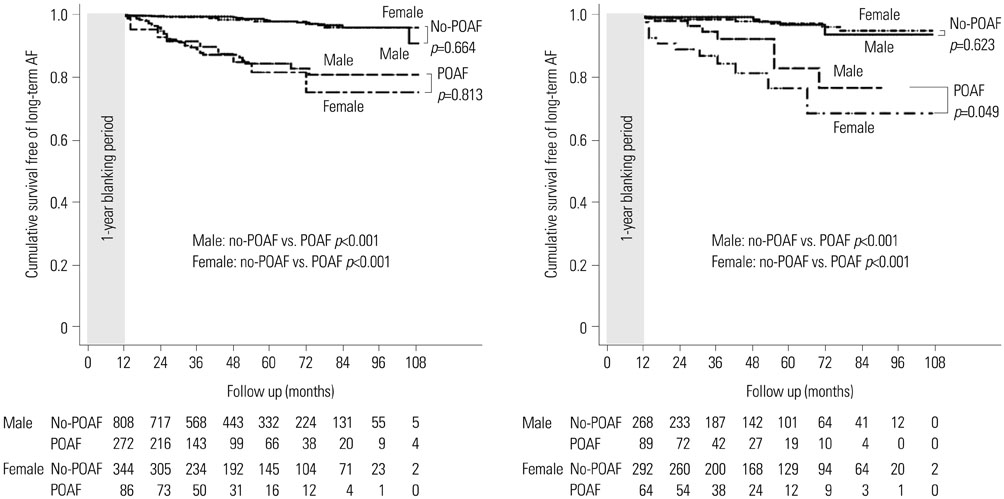Yonsei Med J.
2017 Nov;58(6):1119-1127. 10.3349/ymj.2017.58.6.1119.
Gender Difference in the Long-Term Clinical Implications of New-Onset Atrial Fibrillation after Coronary Artery Bypass Grafting
- Affiliations
-
- 1Division of Cardiology, Department of Internal Medicine, Severance Hospital, Yonsei University College of Medicine, Seoul, Korea. cby6908@yuhs.ac
- 2Department of Biochemistry and Molecular Biology, Brain Korea 21 PLUS Project for Medical Science, Yonsei University College of Medicine, Seoul, Korea.
- 3Division of Cardiology, National Health Insurance Service Ilsan Hospital, Goyang, Korea.
- KMID: 2418893
- DOI: http://doi.org/10.3349/ymj.2017.58.6.1119
Abstract
- PURPOSE
New-onset postoperative atrial fibrillation (POAF) is associated with poor short- and long-term outcomes after isolated coronary artery bypass graft (CABG) surgery. This study evaluated gender differences in the long-term clinical implications of POAF.
MATERIALS AND METHODS
After propensity score matching, a gender-based comparison of long-term (>1 year) newly developed atrial fibrillation (LTAF) and mortality between 1664 (480 females) consecutive patients with (POAF) and without POAF (no-POAF) who had undergone CABG was performed.
RESULTS
During a follow-up of 49±28 months, cumulative survival free of LTAF was lower in the POAF group than in the no-POAF group for both males (92.1% vs. 98.2%, p<0.001) and females (84.1% vs. 98.0%, p<0.001). However, female patients with POAF more frequently developed LTAF than male POAF patients (13.9 % vs. 6.9%, p=0.049). In multivariate analysis, POAF was a significant predictor of LTAF among males [hazard ratio (HR) 4.91; 95% confidence interval (CI) 1.22-19.79, p=0.031] and females (HR 16.50; 95% CI 4.79-56.78; p<0.001). POAF was a predictor of long-term mortality among females (adjusted HR 3.96; 95% CI 1.13-13.87, p=0.033), but not among males.
CONCLUSION
Although POAF was related to LTAF in both genders, cumulative survival free of LTAF was poorer among females than among males. Additionally, a significant correlation with long-term mortality after CABG was observed among female patients with POAF.
Keyword
MeSH Terms
-
Aged
Atrial Fibrillation/epidemiology/*etiology/mortality
Coronary Artery Bypass/*adverse effects/mortality
Coronary Artery Disease/*surgery
Female
Humans
Male
Middle Aged
Multivariate Analysis
Postoperative Complications/*epidemiology
Postoperative Period
Propensity Score
Proportional Hazards Models
Republic of Korea
Retrospective Studies
Sex Factors
Survival
Time Factors
Figure
Reference
-
1. Maisel WH, Rawn JD, Stevenson WG. Atrial fibrillation after cardiac surgery. Ann Intern Med. 2001; 135:1061–1073.
Article2. Ommen SR, Odell JA, Stanton MS. Atrial arrhythmias after cardiothoracic surgery. N Engl J Med. 1997; 336:1429–1434.
Article3. Shantsila E, Watson T, Lip GY. Atrial fibrillation post-cardiac surgery: changing perspectives. Curr Med Res Opin. 2006; 22:1437–1441.
Article4. Lahtinen J, Biancari F, Salmela E, Mosorin M, Satta J, Rainio P, et al. Postoperative atrial fibrillation is a major cause of stroke after on-pump coronary artery bypass surgery. Ann Thorac Surg. 2004; 77:1241–1244.
Article5. Mathew JP, Parks R, Savino JS, Friedman AS, Koch C, Mangano DT, et al. Multi-Center Study of Perioperative Ischemia Research Group. Atrial fibrillation following coronary artery bypass graft surgery: predictors, outcomes, and resource utilization. JAMA. 1996; 276:300–306.
Article6. Almassi GH, Schowalter T, Nicolosi AC, Aggarwal A, Moritz TE, Henderson WG, et al. Atrial fibrillation after cardiac surgery: a major morbid event? Ann Surg. 1997; 226:501–511.7. Albahrani MJ, Swaminathan M, Phillips-Bute B, Smith PK, Newman MF, Mathew JP, et al. Postcardiac surgery complications: association of acute renal dysfunction and atrial fibrillation. Anesth Analg. 2003; 96:637–643.
Article8. Aranki SF, Shaw DP, Adams DH, Rizzo RJ, Couper GS, VanderVliet M, et al. Predictors of atrial fibrillation after coronary artery surgery. Current trends and impact on hospital resources. Circulation. 1996; 94:390–397.
Article9. Ahlsson A, Bodin L, Fengsrud E, Englund A. Patients with postoperative atrial fibrillation have a doubled cardiovascular mortality. Scand Cardiovasc J. 2009; 43:330–336.
Article10. Lee SH, Kang DR, Uhm JS, Shim J, Sung JH, Kim JY, et al. New-onset atrial fibrillation predicts long-term newly developed atrial fibrillation after coronary artery bypass graft. Am Heart J. 2014; 167:593–600.
Article11. Ho DE, Imai K, King G, Stuart EA. MatchIt: Nonparametric preprocessing for parametric causal inference. J Statistical Software. 2011; 42:1–28.12. Zaman AG, Archbold RA, Helft G, Paul EA, Curzen NP, Mills PG. Atrial fibrillation after coronary artery bypass surgery: a model for preoperative risk stratification. Circulation. 2000; 101:1403–1408.
Article13. Dagres N, Nieuwlaat R, Vardas PE, Andresen D, Lévy S, Cobbe S, et al. Gender-related differences in presentation, treatment, and outcome of patients with atrial fibrillation in Europe: a report from the Euro Heart Survey on Atrial Fibrillation. J Am Coll Cardiol. 2007; 49:572–577.
Article14. Villareal RP, Hariharan R, Liu BC, Kar B, Lee VV, Elayda M, et al. Postoperative atrial fibrillation and mortality after coronary artery bypass surgery. J Am Coll Cardiol. 2004; 43:742–748.
Article15. Landymore RW, Howell F. Recurrent atrial arrhythmias following treatment for postoperative atrial fibrillation after coronary bypass operations. Eur J Cardiothorac Surg. 1991; 5:436–439.
Article16. Rubin DA, Nieminski KE, Reed GE, Herman MV. Predictors, prevention, and long-term prognosis of atrial fibrillation after coronary artery bypass graft operations. J Thorac Cardiovasc Surg. 1987; 94:331–335.
Article17. Kowey PR, Stebbins D, Igidbashian L, Goldman SM, Sutter FP, Rials SJ, et al. Clinical outcome of patients who develop PAF after CABG surgery. Pacing Clin Electrophysiol. 2001; 24:191–193.
Article18. Cioffi G, Cemin C, Russo TE, Pellegrini A, Terrasi F, Ferrario G. Post-discharge recurrences of new-onset atrial fibrillation following cardiac surgery: impact of low-dose amiodarone and betablocker prophylaxis. Ital Heart J. 2000; 1:691–697.19. Antonelli D, Peres D, Freedberg NA, Feldman A, Rosenfeld T. Incidence of postdischarge symptomatic paroxysmal atrial fibrillation in patients who underwent coronary artery bypass graft: long-term follow-up. Pacing Clin Electrophysiol. 2004; 27:365–367.
Article20. Ahlsson A, Fengsrud E, Bodin L, Englund A. Postoperative atrial fibrillation in patients undergoing aortocoronary bypass surgery carries an eightfold risk of future atrial fibrillation and a doubled cardiovascular mortality. Eur J Cardiothorac Surg. 2010; 37:1353–1359.
Article21. Stewart S, Hart CL, Hole DJ, McMurray JJ. A population-based study of the long-term risks associated with atrial fibrillation: 20-year follow-up of the Renfrew/Paisley study. Am J Med. 2002; 113:359–364.
Article22. Filardo G, Hamilton C, Hebeler RF Jr, Hamman B, Grayburn P. New-onset postoperative atrial fibrillation after isolated coronary artery bypass graft surgery and long-term survival. Circ Cardiovasc Qual Outcomes. 2009; 2:164–169.
Article23. Mariscalco G, Engström KG. Atrial fibrillation after cardiac surgery: risk factors and their temporal relationship in prophylactic drug strategy decision. Int J Cardiol. 2008; 129:354–362.
Article24. Carson JL, Scholz PM, Chen AY, Peterson ED, Gold J, Schneider SH. Diabetes mellitus increases short-term mortality and morbidity in patients undergoing coronary artery bypass graft surgery. J Am Coll Cardiol. 2002; 40:418–423.
Article25. Rajakaruna C, Rogers CA, Suranimala C, Angelini GD, Ascione R. The effect of diabetes mellitus on patients undergoing coronary surgery: a risk-adjusted analysis. J Thorac Cardiovasc Surg. 2006; 132:802–810.
Article26. Pirracchio R, Resche-Rigon M, Chevret S. Evaluation of the propensity score methods for estimating marginal odds ratios in case of small sample size. BMC Med Res Methodol. 2012; 12:70.
Article27. Feinberg WM, Blackshear JL, Laupacis A, Kronmal R, Hart RG. Prevalence, age distribution, and gender of patients with atrial fibrillation. Analysis and implications. Arch Intern Med. 1995; 155:469–473.
Article
- Full Text Links
- Actions
-
Cited
- CITED
-
- Close
- Share
- Similar articles
-
- Amiodarone Versus Propafenone to Treat Atrial Fibrillation after Coronary Artery Bypass Grafting: A Randomized Double Blind Controlled Trial
- Clinical Results of Mitral Valvular Surgery in Patients with Moderate Ischemic Mitral Regurgitation Undergoing Coronary Artery Bypass Grafting
- Risk Factors of Atrial Fibrillation after Coronary Artery Bypass Grafting
- Use of Preoperative Transthoracic Echocardiography to Predict the Prognosis after Off-Pump Coronary Artery Bypass Grafting
- Wrapping of an Ascending Aortic Aneurysm with the Multiple Boot-Straps Technique in a Patient Undergoing Off-Pump Coronary Artery Bypass Grafting




